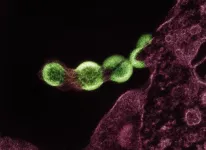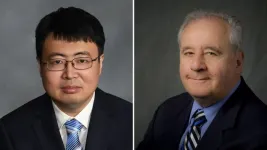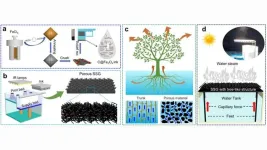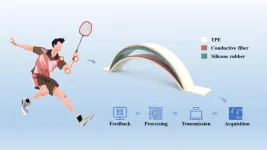Since that study’s publication, scientists at The Ohio State University have been exploring how the SARS-CoV-2 virus that causes COVID-19 prompts this human molecule’s destructive activity, and outlined the series of steps needed to fully describe what’s going on – as well as potential strategies to stop the damage.
The grant from the National Institutes of Health (NIH) will fund their five-year pursuit of definitive answers and development of new ways to treat acute SARS-CoV-2 infections and, ideally, fend off long COVID. The award is the largest of its kind funding infectious diseases research at Ohio State.
The 2022 published research showed in mice infected with SARS-CoV-2 that blocking this molecule, an enzyme called caspase 11, resulted in lower inflammation and tissue injury and fewer blood clots in the animals’ lungs. The researchers also found that the human version of the enzyme, called caspase 4, was highly expressed in COVID-19 patients hospitalized in the ICU – confirming the molecule’s link to severe disease.
The new work funded by the NIH will extend the investigation beyond the lungs based on predictions that in response to the viral infection, caspase 11 has compounding effects in multiple cells: driving up inflammation in the body and brain, interfering with the immune response and leading to clots in small blood vessels. The team will also explore how SARS-CoV-2 infection shapes host and viral RNA modifications, which occur during gene activation and alter cell functions.
Many of the affected cells being investigated are related to the immune response – both the innate response, the body’s first line of defense against any foreign invader, and the adaptive response, which is a later, specific response to a given pathogen. Researchers will also examine cells that line organ surfaces and blood vessel walls (epithelial and endothelial cells, respectively) as well as RNA modifications.
“When you pull it all together, offering the scientific community a basic understanding of what happens to every cell and every organ during SARS-CoV-2 is an achievement in itself,” said Amal Amer, professor of microbial infection and immunity in Ohio State’s College of Medicine and the contact principal investigator on the grant.
“Once you know the mechanism, then you can design what to target, where to target it and how to target it in order to reduce the damage being done,” Amer said. “And this is especially needed for long COVID – it may be in the brain, it may be in the muscles, it may be in anything and everything – and that’s an important aspect of the disease.”
The federal award is a multi-principal investigator (PI) research program project grant composed of three scientific projects and four core activities (see descriptions below). Along with Amer, Estelle Cormet-Boyaka and Jianrong Li, both professors of veterinary biosciences at Ohio State, are MPIs on the initiative. The group also involves other experts from Ohio State, Nationwide Children’s Hospital and the University of Chicago.
Amer is an expert in innate immunity who has been studying the class of molecules called inflammasomes for years. She will lead studies of the role of caspase 11, which is an inflammasome-related enzyme, in causing inflammation in the brain and lung that drives the damaging interplay between the innate immune response and blood clot formation.
Cormet-Boyaka is an expert in lung biology, physiology and pathology, and will oversee studies of the multiple cell types whose functions are influenced, mostly negatively, by the presence of caspase 11 during SARS-CoV-2 infection.
“In addition to studying mice, we’ll also be using human cell samples that enable us to dissect mechanisms at the cellular level,” she said. “Having access to human primary epithelial cells is a strength because those are the cells that the virus infects first.”
Li is a virologist who has been studying respiratory viruses for more than 25 years. He and colleagues will map SARS-CoV-2-induced RNA modifications in host cells and work on experimental inhibitors of molecules that trigger the RNA changes as a strategy to suppress the virus’s ability to make copies of itself in infected cells. The team will develop and test RNA modification and caspase 11 blockers to synergistically reduce SARS-CoV-2 replication, pathology and clotting, protect tissue and prevent the over-production of pro-inflammatory proteins called cytokines.
“The two major causes of death from COVID are the cytokine storm and uncontrolled virus replication,” Li said. “If we inhibit only one of these, it’s not ideal. If we inhibit both, that can lead to a better therapeutic approach.”
Based on data collected since the 2022 study, blocking caspase 11 remains a chief goal – but getting the right drug formulated to do it requires the information that will be uncovered by the combined projects. Though mice lacking the gene to make caspase 11 look and act normal, the research team wants to zero in on inhibitors that pose the lowest risk for side effects.
“When you inhibit caspase 11, you get rid of many cytokines, which damage the lung tissue and the blood-brain barrier and brain tissue,” Amer said. “Combining that together with stopping viral replication is going to be very effective at reducing deaths and severe illness from SARS-CoV-2 infection, and reducing the post-infection symptoms experienced by people with long COVID.”
Conducting simultaneous studies on different tracks will accelerate the pace of the research, said Prosper Boyaka, chair of veterinary biosciences at Ohio State and the leader of one of the three projects. An expert in the adaptive immunity that is a major player in anti-viral immunity, Boyaka will also provide a strategy to tackle immune cells called neutrophils to avoid exacerbated immune responses.
“Long COVID is extremely complex. And the way we do science is to understand mechanisms – but because of our collective own expertise and the tools we have, we will approach one area or one question at a time,” he said. “Having a team like this one allows us to look at those interactions and processes at the same time by experts in different fields, which makes it more likely we will capture information that would be difficult to capture otherwise. That’s why I think the outcome is likely to be more beneficial than if each project were done individually or in isolation.”
Xiaoli Zhang, an associate professor-clinical in the Department of Biomedical Informatics and Center for Biostatistics at Ohio State, is a team scientist in a broad range of biomedical research areas, mainly in cancer and microbial infection and immunity. With expertise ranging from experimental design to biostatistics and bioinformatics data analysis and modeling, she will oversee all bioinformatic and statistical analysis in the project grant.
Amer noted that program grants are very competitive, and successful applications are those that prove the PIs have a track record of working together on significant research – an indication that the team will work together efficiently for the duration of the grant.
“Being at Ohio State, we have people specializing in everything we needed for this grant, and we provided a huge list of publications going back 10 years showing we have continuously worked together and published together on cutting-edge science,” she said. “And the NIH was convinced that this group is the one that can do this.”
Grant title: “Role of the non-canonical inflammasome in SARS-CoV-2-mediated pathology and coagulopathy.”
Project 1: Role of caspase 11 in SARS-CoV-2-induced lung pathologies and long-term immune protection (Project Leader: Prosper Boyaka; Co-Investigators: Estelle Cormet-Boyaka, Jacob Yount) Project 2: Caspase 11-dependent immunothrombosis and neuroinflammation during SARS-CoV-2 infection (Project Leader: Amal Amer; Co-Investigators: Stephanie Seveau, Andrea Tedeschi) Project 3: Caspase 11-dependent RNA modifications and their Role in Multi-Organ Pathologies (Project Leader: Jianrong Li; Co-Investigators: Mark Peeples, Chuan He) Administrative Core (Core Leader: Amal Amer; Co-Investigators: Estelle Cormet-Boyaka, Jianrong Li) Biostatistics and Bioinformatics Core (Core Leader: Xiaoli Zhang; Co-Investigators: Maciej Pietrzak, Amy Webb) Biological Reagents and Infection Core (Core Leader: Jianrong Li; Co-Investigator: Mark Peeples) Cell Derivation and Maintenance Core (Core Leader: Estelle Cormet-Boyaka; Co-Investigator: Santiago Partida-Sanchez)
#
Contact: Amal Amer, Amal.Amer@osumc.edu
Written by Emily Caldwell, Caldwell.151@osu.edu; 614-292-8152
END





